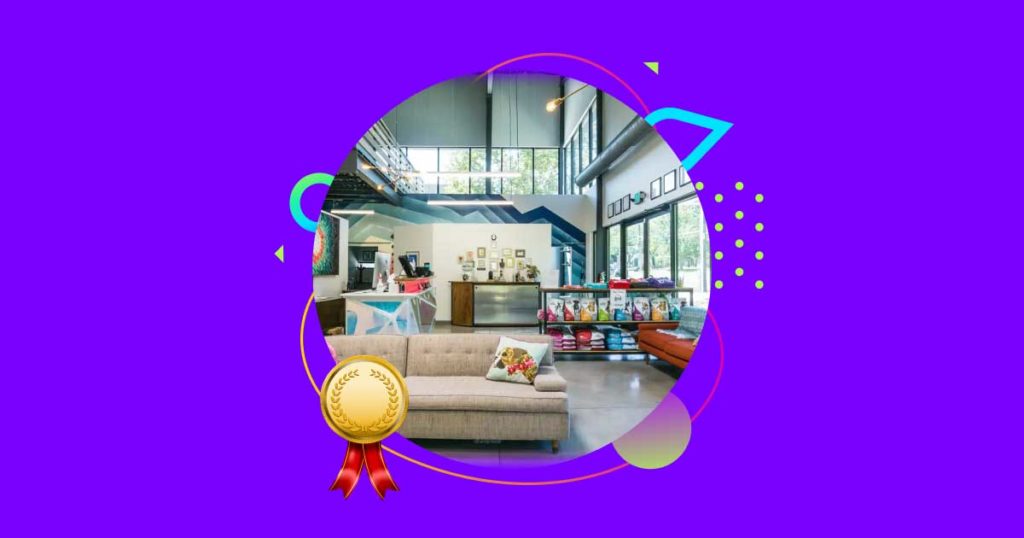5 Veterinary Hospital Design Tips from Award-Winning Hospital Owners

Building or renovating a veterinary hospital is no small endeavor, but making minor improvements can mean big rewards for a veterinary practice. We looked at some of the most successful and well-designed veterinary hospitals and learned some veterinary hospital design tips to improve any facility. Whether you are looking to build an all-new building, renovate a current facility, or even paint the walls, the following veterinary hospital design pointers are sure to make your project successful.
Free eBook: Vetstoria’s Veterinary Start-Up eGuide
1. Build a welcoming lobby area
They say you never get a second chance to make a first impression, and they are right. We spoke to owners of award-winning hospitals about veterinary hospital design unanimously felt that it was essential to focus significant time and energy on developing a great lobby area. In the past, many veterinary clinics were designed to have a very sterile and medical feeling to them, but experts say this is a mistake. Pets, their owners, and even your very own employees want to enter into a welcoming atmosphere. Lobbies should be designed to look more like homes, with soft lighting, flooring that resembles wood or stone, and cheerful decorations. Furniture should be comfortable and well-spaced to allow pets to keep their distance from other animals and clients while waiting.
Additionally, it is important to consider acoustics. Dogs can be noisy, and the best-designed hospitals have soft walls and other noise abatement measures to decrease the ambient sound level. Furthermore, when asked, the most frequent complaint from pet owners who visited veterinary hospitals was related to unpleasant smells. To address odor, floor selection is important to consider, and many hospital owners recommend specialized HVAC systems that can help clean and deodorize the air.
2. Give your practice a modern twist
Not all of the award-winning veterinary hospital designs that we researched were newly built. They did; however, all appear modern and up-to-date. A run-down, old, or out-of-style hospital sends the wrong message to clients. A contemporary look will not only be more attractive and draw in more business, but it will also improve workflow and clinic efficiency. Modern elements in demand now include upgraded materials such as vinyl or tile plank flooring, granite counters, stylish lighting with LED bulbs, and large windows that allow as much natural light in as possible. Barn doors and large paintings are also trendy features. Reception areas should be open concept and free from clutter, shelving, or privacy paneling. Many hospitals are using eco-friendly and “green” materials in their builds to promote the health of the employees and patients. These materials can also be utilized as a marketing tool to show the practice’s commitment to its patients and the environment.
3. Create an efficient flow
Clients, pets, and staff all desire the veterinary hospital design to be aesthetically pleasing and welcoming. However, it is also essential that the layout of the floorplan flows well. A difficult-to-navigate hospital will lead to congestion, patient, and employee traffic jams, wasted time, and headaches for everyone. When designing the floorplan, the traffic of the clients, pets, and busy employees should be considered, will travel throughout the hospital. There should be an easy path for clients and their pets from the lobby to an exam room to check out and back outside. The pharmacy should be close to where clients check out. Deeper inside the facility, sterile rooms like surgery need to be in areas with restricted access. There should also be a dedicated area of isolation of contagious animals. Exam rooms should be large enough to comfortably accommodate multiple pets, clients, technicians, and veterinarians. If space allows, two doors with two hallways on opposing sides of each exam room are ideal for workflow.
4. Adopt veterinary technology
Today’s pet owners feel that their pets are part of the family. As a veterinary hospital, you are expected to provide high-level and advanced care. The award-winning hospitals with the best veterinary hospital design that we took tips from offered many advanced diagnostics, including digital radiography, computed tomography, magnetic resonance imaging, endoscopy, ultrasound, nuclear medicine, and more. The chance to build a new facility or renovate an existing one is a perfect time to incorporate these diagnostic capabilities into your practice. Not only will these technologies benefit your practice and your patients, many of the hospitals we spoke with offered those services for doctors from surrounding areas, which was an easy revenue generator for their practices.
5. Offer additional revenue sources
When planning a new facility or renovating an existing one, it is wise to look for additional ways to bring revenue into the practice. Many owners report that adding some of these additional revenue streams paid for the renovations they were making. Some examples of new services to offer when designing or renovating a veterinary hospital are boarding, grooming, retail (such as pet food, treats, toys, etc.), dentistry, daycare, behavior training, and hydrotherapy. Each service’s space and design needs vary considerably, but today’s busy pet parents appreciate one-stop shopping. Adding additional services and products to your hospital’s offerings can be a massive bonus to your bottom line.
Final thoughts
Veterinary hospital design is a crucial piece of a practice’s strategy to improve client satisfaction and employee retention. Clients are pleased when they feel comfortable and welcome in a veterinary hospital and believe they get many needed services and state-of-the-art medical care. Additionally, both doctors and support staff have improved morale and job satisfaction when they work in pleasant surroundings with adequate workspace, good flow, and high-quality equipment—this aids in employee retention for all positions within the practice. Thoughtful veterinary hospital design provides numerous benefits for a veterinary practice that will continue to pay off for years to come.
About the author
Vetstoria
Vetstoria’s real-time online booking drastically reduces phone calls and keeps you in control. So you can focus on what matters most – providing quality pet care. Made for vets, by vets.